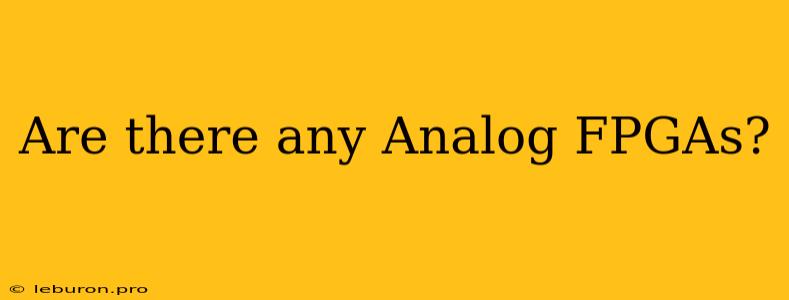Are There Any Analog FPGAs?
The realm of Field-Programmable Gate Arrays (FPGAs) is typically associated with digital logic and signal processing. They excel at manipulating digital data, offering unparalleled flexibility and customization in hardware design. But what about the analog world? Is it possible to find FPGAs capable of handling analog signals directly? The answer, while not as straightforward as a simple yes or no, lies in understanding the nuances of FPGA technology and the evolving landscape of analog circuit design.
The Digital Nature of FPGAs
FPGAs, at their core, are built around programmable logic blocks (PLBs) and interconnects. These PLBs are essentially small digital circuits that can be configured to perform various logical operations, like AND, OR, XOR, and others. The interconnects allow these PLBs to be connected together, creating complex digital circuits. This digital nature is fundamental to how FPGAs operate, and it creates a significant challenge when it comes to direct analog processing.
Analog Processing: A Different World
Unlike digital signals that exist in discrete states (0 or 1), analog signals vary continuously over a range of values. This continuous nature makes analog processing fundamentally different from digital. Analog circuits are designed to manipulate these varying signals, often using components like capacitors, resistors, and transistors to achieve functions like amplification, filtering, and waveform generation.
The Gap Between Digital and Analog
The gap between digital and analog processing is where the challenge arises. FPGAs, with their digital nature, are not inherently equipped to handle analog signals directly. They rely on discrete voltage levels representing digital values, making it difficult to represent the continuous nature of analog signals. However, this doesn't mean analog processing is entirely out of reach for FPGAs.
Bridging the Gap: Mixed-Signal FPGAs
One approach to tackling this challenge lies in mixed-signal FPGAs. These devices incorporate dedicated analog components alongside their digital logic blocks. This allows them to handle analog signals and perform certain analog functions within the FPGA fabric. Examples of such functions include:
- Analog-to-digital conversion (ADC): Mixed-signal FPGAs often feature ADCs, allowing them to sample and convert analog signals into digital values for further processing within the FPGA.
- Digital-to-analog conversion (DAC): Similarly, DACs allow the FPGA to generate analog signals based on digital data.
- Analog signal conditioning: These FPGAs can incorporate basic analog circuitry for functions like filtering, gain control, and impedance matching.
Limitations of Mixed-Signal FPGAs
While a significant step towards analog processing, mixed-signal FPGAs still have limitations. They are not as flexible or customizable as their purely digital counterparts when it comes to analog functions. The analog components are typically fixed, offering limited options for tailoring analog behavior. Furthermore, the integration of analog circuits within the FPGA can introduce noise and distortion, impacting signal quality.
Beyond the FPGA: Analog Front-Ends
Another approach involves using dedicated analog front-ends for signal processing. These front-ends are external to the FPGA and perform tasks like signal conditioning, amplification, and filtering before sending the data to the FPGA for digital processing. The FPGA then handles the complex digital operations like data analysis, control logic, and algorithm execution.
This approach separates analog and digital processing, maximizing the strengths of each. The analog front-end is optimized for handling the intricacies of analog signals, while the FPGA handles the digital logic and complex computation with high efficiency.
Emerging Technologies: Analog Computing
The landscape of analog processing within FPGAs is constantly evolving. Researchers and developers are exploring emerging technologies like:
- Memristor-based FPGAs: Memristors, devices with memory resistance, have the potential to provide a more natural way to represent and process analog signals.
- Neuro-inspired computing: This approach leverages the principles of biological neural networks, potentially enabling FPGAs to perform complex analog computations in a more efficient and flexible manner.
- Analog-to-digital converter (ADC) technology advancements: Ongoing research into high-speed, high-resolution ADCs is improving the ability to capture and digitize analog signals with greater accuracy.
Conclusion: The Future of Analog Processing in FPGAs
While FPGAs have traditionally focused on digital logic, the demand for analog processing capabilities is driving innovation. Mixed-signal FPGAs, external analog front-ends, and emerging technologies like memristor-based FPGAs and neuro-inspired computing are pushing the boundaries of what's possible in FPGA-based analog signal handling. The future of analog processing in FPGAs holds exciting possibilities, promising greater flexibility, accuracy, and integration for a wide range of applications.
